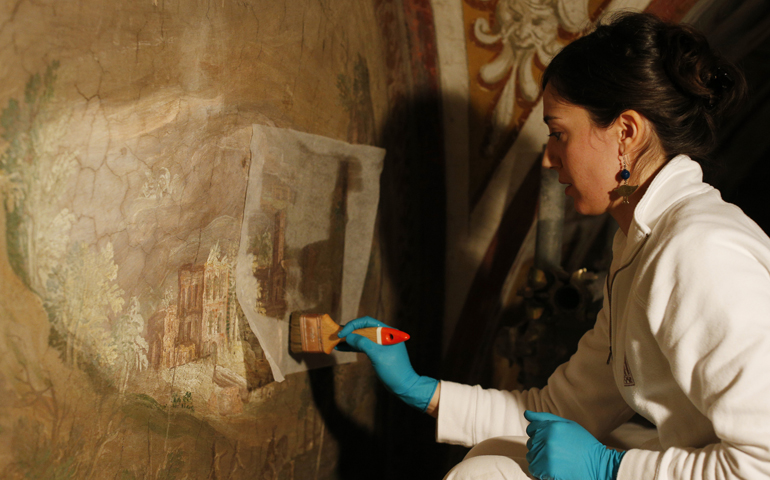
Chiara Munzi uses special Japanese paper as she restores a fresco by Flemish master Paul Bril in the San Lorenzo Chapel adjacent to the Holy Stairs on Feb. 28 in Rome. (CNS/Paul Haring)
A restorer carefully peeled back a thin wet veil of paper from a black sooty wall to see what was hidden underneath.
From behind the layers of grime and dirt emerged the frescoed images of a fallen Roman column, a flock of fluffy sheep and a pink sunset sky over a forgotten ancient city.
The surprise that restorer Chiara Munzi was unveiling was a 16th-century fresco by Flemish master Paul Bril -- a rich, colorful landscape scene that hadn't been seen with such vivid detail for centuries.
Four levels of scaffolding put restorers and visitors within inches of freshly uncovered images of trailing ivy, angels playing lutes, the solemn and wise faces of doctors of the church, and bucolic landscapes.
Bringing blackened or dulled walls and ceilings back to their original "brightness and immediacy transports us right back to the moment they were painted," Paolo Violini, the Vatican Museums' top expert in fresco restoration, told Catholic News Service.
A team of nearly a dozen restorers spent nine months just on the chapel's vaulted ceiling. They are using surgical scalpels, pulses of laser light, de-oxidizing chemicals, thin Japanese paper sprayed with ammonium bicarbonate and soft sea sponges to bring back the original splendor of the medieval sanctuary's 18,300 square feet of Renaissance frescoes and decorative paintings.
In addition to the frescoed chapels and walls, the pontifical sanctuary houses the Scala Santa, or Holy Stairs.
According to tradition, the Holy Stairs are the ones Jesus climbed when Pontius Pilate brought him before the crowd and handed him over to be crucified. It's said that Constantine's mother, St. Helen, brought the stairs to Rome from Jerusalem in 326 A.D.
The 28 marble steps are covered with thick wood panels, now worn smooth from centuries of human traffic. A minimum of 2,000 pilgrims a day visit the shrine, and many of them climb the stairs on their knees, pray at the Sancta Sanctorum -- the first private chapel of the popes -- and venerate a silver and jewel-covered Byzantine image of Christ.
The sanctuary, dedicated to the Passion of Christ, is entrusted to the care and protection of the Passionist fathers, who have a special devotion to Christ's passion.
The sanctuary's rector, Passionist Fr. Francesco Guerra, told CNS that the Holy Stairs shrine is a unique place of worship in Rome.
"When we pray and at the same time we do something that is physical" -- like climbing the stairs on one's knees -- "we may in some way feel that we may touch what Jesus touched at that time, and we feel that we are near Jesus," he said.
Guerra said many people who come to the sanctuary are experiencing a difficult moment in life, and they offer "their own suffering to Jesus to be near him, to be helped by him."
U.S. art gallery curator Mary Angela Schroth is coordinating the Holy Stairs project. She said it was difficult and slow-going to get the needed funding and support to restore such a complex and large sanctuary.
"It's not glamorous like the Sistine Chapel. This is the people's sanctuary," a place that has been popular with and loved by simple people of faith for centuries, she said.
The fame of Michelangelo's frescoes in the Sistine Chapel has, in a sense, overwhelmed its intended spiritual significance and purpose as an active place of worship, she said.
The Sanctuary of the Holy Stairs' restoration "is really a project to renew faith" and support people's "spiritual experience of the Holy Stairs," not just preserve its historic art, Schroth said.
The Vatican Museums is overseeing the restoration project, which should take another five years to complete, culminating in the cleaning of the frescoes along the Holy Stairs; the frescoes depict Christ's journey from the Last Supper to his passion, death, resurrection and ascension into heaven.
The work is being funded through the Vatican Museums' Patrons of the Arts chapters and donors in the United Kingdom, Florida, North Carolina and South Carolina.
The patrons coordinate funding from people worldwide to help restore and preserve, not just the museums' in-house collections, but any architectural or artistic treasure belonging to the Vatican. That includes properties outside the walls of Vatican City, like the sanctuary, which is located near the Basilica of St. John Lateran.
The preliminary studies needed for restoring the entire sanctuary had been completed more than a decade ago. "The last piece of the puzzle was the financial support, so that's why the patrons got involved," said Legionaries of Christ Fr. Mark Haydu, director of the museums' Patrons of the Arts office.
Haydu said sacred art is invaluable, not just for its material beauty, but also for its power to help transform people's lives.
"If it can even bring solace to someone who's suffering, if it can convince someone mired in a challenge, a difficulty, a weakness, that they can't find the moral courage to overcome, and have a spiritual experience before the passion of Christ, for example," then the church needs to care for that heritage, too, he said.
"If that missing link is the atmosphere that helps them get over the hump, well, there's infinite value there," the U.S. priest said. "The financial investment, the returns go beyond anything anyone could ever imagine and that's what's powerful, that's what's beautiful and that's why the church cares about its art in the end."